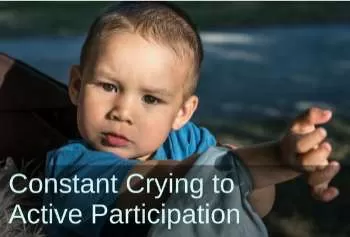Primitive Reflex Integration Case Studies
Constant Crying to Active Participation
Preschooler with severe anxiety gains regulation and starts engaging in fine motor activities.
Crying and asking to be picked up were the norm for this 3-year-old boy, who showed no interest in exploring his environment. See how rhythmic movements greatly impacted his emotional regulation and ability to participate in the classroom.
Submitted by Sheri Seagle, OTR/L

| Before | After |
|---|---|
| Constant intense crying and requests to be picked up | Decreased crying |
| Demonstrated no exploration of the classroom or toys | Has significantly increased his exploration of the class/toys |
| During table time, would only sit on the associate's lap; cried if activities were presented to him | Participation in table time activities improved, now engaging in activities with assistance given as needed and close adult proximity |
Colt just turned 3 and started in the Pre KG ASD classroom (public school system) the last day of January. He receives 60 minutes per week of direct OT [Occupational Therapy] services provided on an individual basis. Currently, OT is provided in the classroom. I work with the entire class twice per week [one day for big motor/sensory work and the next day for table time with fine motor tasks]. The students that are individual on their OT plan of care are encouraged but not forced to participate in whole group activities.
"From his first day of school, Colt’s behavior consisted of constantly crying and seeking to be picked up all day, every day for several weeks. Colt cried until his face was beet red and he was gasping. He didn’t want to walk. He demonstrated no exploration of the classroom or toys. During table time, Colt only sat on the associate's lap. He would cry if activities were presented to him. He only wanted to be held."
When I attempted to engage him in tasks, Colt wouldn’t participate unless it was to be held or sit on my lap. I chose Colt for the second case study with the goal of helping him become more comfortable in his own body and in the classroom so that he would increase his exploration and participation.
I started providing rhythmic movements, tapping, and massage/joint compression [from the Brain and Sensory Foundations program]. My focus was only to provide the positive sensory input and to attempt to engage him in tasks. During the first session with the movements, Colt initially resisted, but after a few minutes, he enjoyed this activity as evidenced by him smiling and presenting his arms and legs for more movement and compression. If I began working with another student, Colt would come and interfere trying to get more of the movements -- he would literally sit on top of me or climb over the other student. I see Colt twice per week for 30-minute sessions. However, when I am in the classroom working with other students (I am in the class 4 days per week), I provide positive sensory input to Colt as I am able-typically he got at least 5-10 minutes of input.
When it was his particular session and after providing the sensory input, I attempted to engage Colt in fine motor activities at table time. He needed hand held assistance to transition and he would only remain in area if sitting on an adult’s lap. In each session, the rhythmic movements, tapping, deep pressure input, and joint compression were repeated. The activities were explained to the teacher and the classroom associates. Colt always sought more input. After about 5 sessions of using the rhythmic movements, massage, and joint compression, Colt started to engage more in movement play and fine motor tasks given close adult proximity at table time. When I entered his classroom, Colt came right to me. After the sensory input, Colt engaged in fine motor tasks such as putting objects in slotted containers, picking up small items, etc. while we remained on the floor.
"His participation in table time activities improved. He went from crying the entire time to engaging in the activities, with assistance given as needed and close adult proximity."
Colt still seeks a high amount of input. However, since the provision of the positive sensory input, Colt has significantly increased his exploration of the class/toys, increased his participation at table time, and decreased crying. A home program for the summer was provided that included information about the rhythmic movements.
[Emphasis added]
*Disclaimer: The activities in the Brain and Sensory Foundations curriculum make use of the natural processes of neuroplasticity and development that are innately wired in the design of human beings to promote maturity and function. These activities appear to calm, organize, and mature the neuro-sensory-motor systems just as we see in the healthy development of human infants. Individual results may vary, and we do not claim to offer a diagnosis or cure for any specific condition or disorder. The Brain and Sensory Foundations activities appear to improve overall functioning resulting in measurable improvements for a range of conditions as demonstrated in over 1800 case studies from participants.

